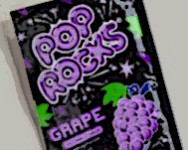Wine Tasting Techniques; How To Taste Better.
Chapter Three. Part Eleven.

Do you remember Pop Rocks – the 1970’s candy made of carbonated sugar granules tinted with some sort of unearthly dye and coated in polyethylene? When eaten, the outer plastic sealant dissolved and a radioactive uranium isotope was released, creating a tiny nuclear reaction in your mouth. But it was a happy nuclear reaction, filled with cheerful little explosions of flavor – just like grandma used to make.
Okay, so maybe it wasn’t polyethylene or a nuclear reaction, but that’s what it felt like. You may find this hard to believe but I try to be completely honest in my writing. I also try to be 175 pounds and that’s not working out so well either.
In a recent post you learned How To Smell Better (for which your spouse has thanked me profusely). This week’s post will give you a tip on How To Taste Better but relax, you won’t have to bathe in butter and garlic.
Today you’ll learn a technique that will let the other restaurant diners know you’ve spent significant time around a Riedel rim. It’s kind of like knowing the secret wine insiders handshake but you don’t actually have to touch anyone.
When analyzing wine you’ll eventually need to stop with all the looking and swirling and sniffing and actually take a drink. Taste buds are spread throughout your mouth and throat, so don’t take a namby-pamby sip. Take a generous mouthful so you can feel it, swish it around, chew on it and let it coat every surface in your mouth. Then let the wine linger on your palate so you can experience the broadest gustatory sensations the wine can offer.
Does your initial impression corroborate your visual and aromatic conclusions? Occasionally a wine displays a wonderful nose, richly aromatic and deeply complex, only to be followed by a palate that seems lean and austere by comparison. It’s a disconcerting feeling when aromas lead you to believe you’ll taste one thing but then you taste something completely different. It’s like the befuddled sensation you get when you travel to the southern hemisphere and the water goes down the toilet counterclockwise instead of clockwise.
You’ve already learned oxygen releases aromas when mixed with wine, but aerating wine as you taste it also releases flavor. To master the art of slurping air into your mouth when it’s filled with wine requires that you either commit the time to practice or commit the money to buy a bib. Here’s how it’s done; after you’ve filled your mouth with wine and squished it around a bit, tilt your head downward and slowly inhale air over the wine through pursed lips. This creates a percolating effect in your mouth but beware, in some wine bars this is considered a mating call.
Percolation aerates the wine, mixing air with aromas that have been activated by your body heat. These supercharged vapors are drawn into the retro-nasal passage at the back of your mouth which connects to your olfactory sensors, thereby maximizing the effects of gusfaction (for those just joining us, gusfaction is word I invented last chapter that means a combination of gustation and olfaction).
Now pay attention because here’s the information that will separate you from the pompous wine aficionado slurping his wine at the next table; this powerful tool will magnify both the good and the bad characteristics of the wine. Professionals use this technique to magnify the flaws in wine so they can avoid purchasing mistakes. If you happen to find yourself at a professional wine tasting, the sound may lead you to believe you’ve wandered into a room full of kindergarteners slurping their last drops of milk through straws.
If you’re analyzing a wine that happens to be out of balance, this percolation technique will intensify the element that’s overdone. Let’s say the alcohol  level is too high, introduce air into your mouth and suddenly the wine has a hot sensation. If the wine is excessively tannic it will become more astringent with aeration, just as wines that are overly acidic will seem exceedingly sharp. I once aerated a wine with overblown oak characteristics and spent several weeks pulling splinters from my gums.
level is too high, introduce air into your mouth and suddenly the wine has a hot sensation. If the wine is excessively tannic it will become more astringent with aeration, just as wines that are overly acidic will seem exceedingly sharp. I once aerated a wine with overblown oak characteristics and spent several weeks pulling splinters from my gums.
But oh my my, when a wine is good, aeration can move it up a notch to great.
You may sense deep-routed complexities when you first taste a wine but the flavors remain elusively indefinable. If only you had the oral equivalent of a microscope, you could pin down these vague flavors. Aeration is the microscope you’re looking for. Give the wine a little percolation and POW! Hold onto your shorts because the once subdued flavors will suddenly explode across your palate like an RV full of rednecks set loose at an all-you-can-eat bacon buffet.
I once demonstrated this percolating technique at a grade school fundraiser, and at the risk of soiling their clothes, I managed to convince several parents to attempt percolating some wine themselves. Upon experiencing this explosive flavor magnification, one young mother squealed, “Oh my! This is like Pop Rocks for adults!”






















